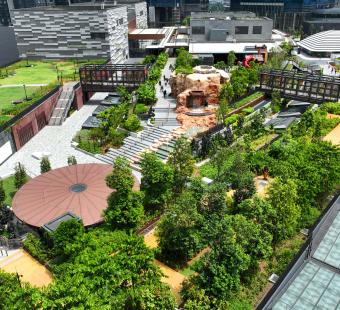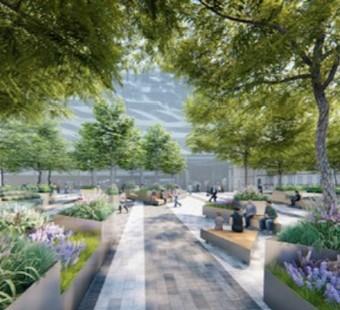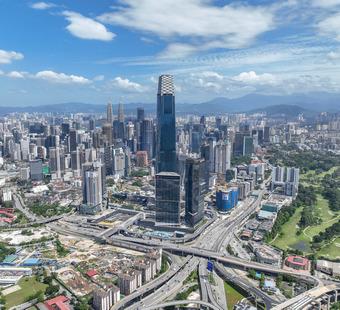The Institution of Engineers, Malaysia (IEM) has conferred TRX City the IEM Outstanding Engineering Achievement Award for 2021 for the design of its Sewerage Treatment Plant (STP), the first private wastewater and recycling plant for TRX.
One of the amazing features of TRX’s wastewater treatment plant is that it fits seamlessly at the heart of the financial district. Unlike traditional sewerage treatment plants, this water recycling plant in TRX is designed to blend well with the district façade. First of its kind in the region, this plant that runs under negative pressure using several new technologies esuring it remains odorless, is expected to help TRX reduce site-wide freshwater demand by half, as it recycles more than 80 percent of the district’s wastewater.
Key to the district’s sustainability framework, the plant has been awarded the IEM Oustanding Engineering Award for 2021.
Each year, the award is presented to an organisation that has completed an outstanding engineering project in Malaysia. The selection process considers several criteria including the project’s contribution to the well-being of people and communities, resourcefulness in planning, creativity in the solution of design problems, and pioneering use of materials and methods. In honouring the winner, the contributions of the engineers involved in the project will be publicised by IEM to the wider society.
TRX’s on-site STP is recognised for its capabilities to recycle an impressive 80 percent of the district’s sewage for non-potable uses, cutting its potable water demand by at least 50 percent. Designed, built and operated by Veolia Water Technologies Southeast Asia (Veolia), the STP targets to recover 100 percent of the expected 3.8 million cubic meters of sewage generated every year, for reuse purposes. These targets will be met by leveraging on five of Veolia’s advanced technologies which are Multiflo™ settler, AnoxKaldnes™ Moving Bed Biofilm Reactor (MBBR) technology, Hydrotech®disc filters, Alizair® deodorisation treatment, and Endetec Kapta units.
Low energy design philosophy also gives the STP the lowest possible specific energy consumption, while the adoption of high-efficiency electrical equipment and an integrated electrical demand management system further minimises footprint. The multiple technologies utilised are an example of the expertise Veolia can provide in going beyond regulation compliance. Veolia is TRX’s partner for district-wide wastewater treatment and recycled water supply, under a 20-year concession agreement.
________________________
Excerpt from TRX’s Submission for the IEM Outstanding Engineering Achievement Award:
The Treatment Plant will treat and recycle sewage from the various buildings for reuse, in order to meet non-potable demands (uses for cooling, toilet flushing and irrigation). The waste is collected and treated at or near the point of generation, to produce a high-quality effluent suitable for reuse close to point of demand.
The approach of STP construction is based on the following reasons:
- To meet sustainability aspirations
- To reap potential saving in water rate cost as we reduce the water demand usage
- To align TRX to KLCP 2020 Strategic Direction 10.6 on water reductions and recycling
To facilitate the development of a sustainable TRX sewerage plan, these items were studied:
- Sewerage Generation
- Sewerage and Treatment Design Criteria
- Sewerage and Treatment Infrastructure
- Building Collection and Distribution Strategy
________________________
Sustainability strategies are incorporated into the Master Plan of TRX from the conceptual stage, as demonstrated in the LEED ND Gold and GBI Township Platinum certifications it has received. Key to this is its water-recycling strategy.
The STP is part of TRX’s larger sustainability framework that promotes a vibrant community supporting economic growth while holistically minimising the impact on the environment. A Sustainability Management System (SMS) has been tailored for the development, serving as a tool that would help TRX achieve a balance between its numerous priorities, enabling TRX to consistently receive feedback for improvement and embed a culture of sustainability within its design, construction and operations, all of which will position the district as an exemplary model of sustainability.
With its newly introduced technological solutions that would result in the highest rates of reclaim water, its low-energy design structure that reduces the carbon footprint for the development, and a smart network that targets to eliminate losses with zero non-revenue water (NRW).
Through its water recycling and energy efficiency measures, TRX’s STP has demonstrated outstanding engineering skills that contribute to the progress of engineering and improvement in the quality of life.
One of the challenges for the STP is to have it built in the middle of a busy commercial hub that can blend seamlessly into its environment. The plant, which is expected to recycle a total of 13,300 litres daily waste, is required to function in an enclosed area, at the very center of TRX, and must not emit any unpleasant smell that would affect its neighbours: office towers, city park, retail and F&B. The new technologies utilised in TRX sewerage treatment network allows for this. The enclosed plant is built as part of a commercial structure, inside the ground floor of a multi-level building integrated with the TRX District Management Office and Veolia’s Office.
The STP consists of three streams:
- Wastewater treatment stream: Main treatment steps include flow equalisation, preliminary treatment (screening, grit and grease removal), primary sedimentation, biological treatment, solid separation/clarification and disinfection by UV and chlorination.
- Sludge treatment stream: The treatment system comprises thickening and dewatering plant sludge cake storage facilities, polymer dosing and preparation.
- Odour treatment stream: Odour generated from process units will be treated with deodorisation unit(DOU) prior to final discharge to the atmosphere. Biofilters together with activated carbon filters are proposed for this application.
---






